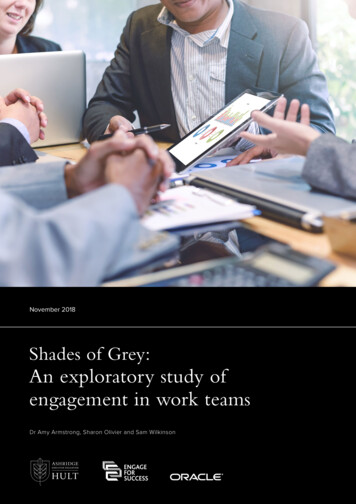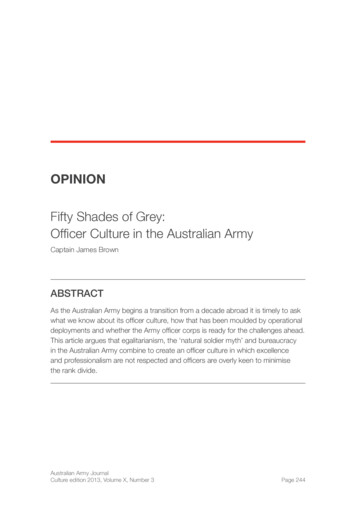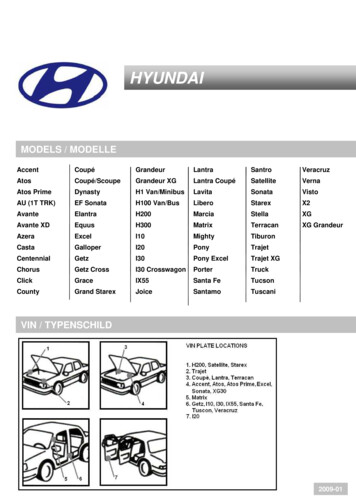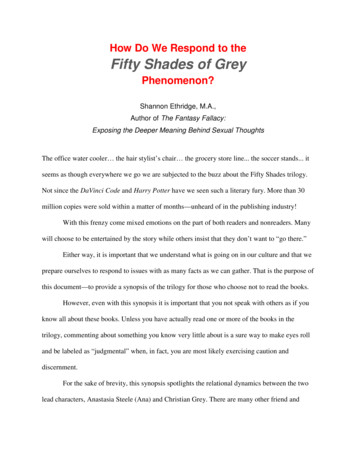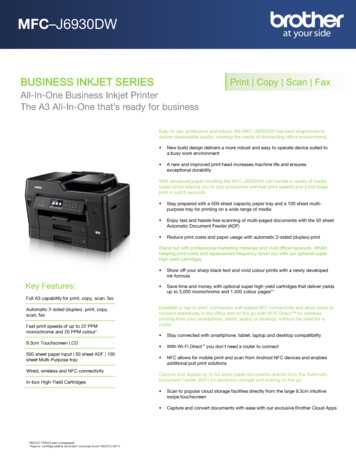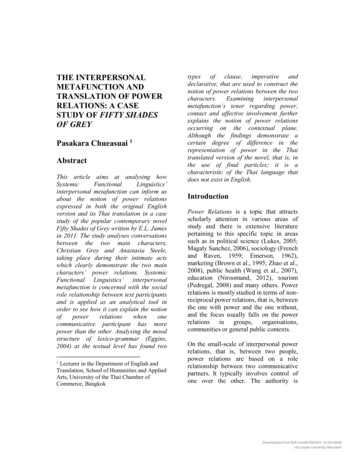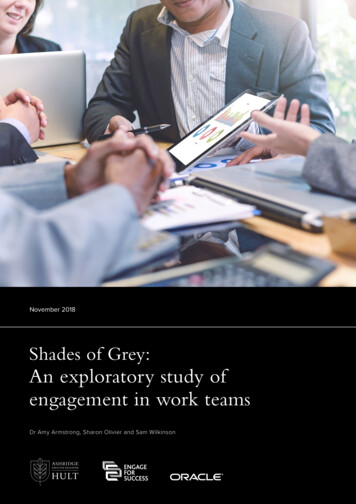
Transcription
November 2018Shades of Grey:An exploratory study ofengagement in work teamsDr Amy Armstrong, Sharon Olivier and Sam Wilkinson
AcknowledgementsWe would like to thank all of the teams who tookpart in this study. If you had not taken time out fromyour busy work schedules, this research would nothave been possible, so we are very grateful.We would also like to thank Mez Fokeer, GraceBrown and Siobhan Renshaw who worked with usduring the data collection phase. Additionally, wewould like to thank Cathy Brown, former ExecutiveDirector at Engage for Success for her guidanceand patience, and Andy Campbell, StrategyDirector at Oracle, for advice on many aspects ofthis project including the Diagnostic.This research project has taken a great deal oftime, so we are very grateful for all yourcontinued support!2
Table of contentsAcknowledgements .2Foreword .4Executive summary .5Introduction .6Engagement - a slippery concept .8What we did .9What we found .11Zone of Contentment .12Zone of Disengagement .14Zone of Pseudo-Engagement.15Zone of Engagement .16Implications .17Next Steps .18References .193
ForewordIt is now widely recognised that employee engagement is ‘a good thing’ and there is awealth of evidence that suggests a link between levels of employee engagement andbusiness performance. However, despite the general acceptance of this phenomenon,it does not appear to have translated into widespread improvements in organisationaloutcomes. National measures of performance and productivity remain stubbornly fat,which suggests that there may be issues concerning adoption or execution.One factor to consider is the signifcant change to the world of work, brought about bythe capabilities of new technology, such as the use of social media to promote a cultureof sharing, connectivity and immediate feedback; the rise of the ‘gig economy’ and morefexible working arrangements; increased team and project-based work supported bymethodologies such as ‘agile’ and ‘fast fail’ that promote rapid development cycles; andgreater transparency of information with a focus on the use of data and evidence-basedmanagement.These changes are challenging traditional models of leadership. Organisations arebecoming less hierarchical, more egalitarian and collaborative, with performance nowoften being measured at the team level rather than that of the individual. As a result, theskills and capabilities of the team leader are more important than ever. Leaders need todemonstrate new skills, behaviours and ways of working that refect the requirements ofthis new digital world.Oracle is delighted to support this research. We believe that it ofers a really valuablecontribution to the debate about how to improve team and organisational performanceas well as the working lives of employees.Andy CampbellHCM Strategy DirectorOracle4
Executive SummaryThis study examines engagement in work teams. In what we believe to be the largest UKstudy of barriers to team engagement to date, researchers from Ashridge Executive Educationat Hult International Business School on behalf of Engage for Success and supported byOracle worked with 195 participants from 28 teams across seven industry sectors. Whencomparing work teams, our fndings suggest that there are ‘shades of grey’ when it comes toteam engagement, opposed to teams simply being either engaged or disengaged. As a result,we have identifed four zones of team engagement:Zone of ContentmentWhere the work is seen as mundane, teams areinward-looking, perceiving themselves as victimsof a system that is defective in some way. Indisengaged teams there are ‘cliques’ and highlevels of mistrust between individuals. The teamleader does not empower or appreciate teammembers and is often see as having ‘favourites’or treating people unequally, which perpetuates anegative team climate.Zone of DisengagementWhere the work is seen as mundane, teams areinward-looking, seeing themselves as victimsof a system that is defective in some way, andwhere there are cliques and high levels of mistrustbetween individuals. In disengaged teams, theteam leader does not empower or appreciate teammembers and is often see as having ‘favourites’or treating people unequally, which perpetuates anegative team climate.Zone of Pseudo-EngagementWhere team members play the system to serve theirown needs, for example, by stretching workloadto fll time, or putting a positive spin on the team’sengagement, which does not refect reality. Teamleaders in pseudo-engaged teams are more interestedintegrating themselves to senior management thanbeing available for their team. In pseudo-engagedteams, people may be engaged individually, howeverthey pull in diferent directions and there is littleevidence of teamwork.Zone of EngagementWhere teams are proactive and solution-focused.In these teams, there is a positive atmosphere.Team members support each other personallyand professionally. They feel trusted, stretched,empowered and valued and are clear aboutwhere their team fts in relation to the biggerpicture. In engaged teams, members value diversity,see confict as inevitable and healthy, and usedisagreements as a source of creativity and insight.This research challenges traditional binary notions of engagement or disengagement and questions ifengagement surveys present the true story when it comes to team engagement. Our fndings show thatthe three most important factors regardless of which zone a team is located in are: ensuring people aregiven challenging and varied work; working with trusted colleagues; and having a team leader who istrusted and leads by example. Our fndings have been translated into a team diagnostic and our aim isto develop leadership programs to help managers to successfully lead teams to raise their collectiveengagement and team performance. This tool is freely available online.55
IntroductionThe weight of evidence connecting engagementto improved organisational outcomes is clear. Companieswith high levels of engagement experience 40% lower staffturnover than companies with low levels of engagement.Companies with top quartile engagement scores achieve12% higher customer advocacy and twice the annual netprofit than those in the bottom quartile (Rayton, Dodge& D’Analeze, 2012).Yet, for many organisations, high staffengagement remains out of reach.Employee engagement has been a focus of attentionwithin the HR community and among leaders forwell over a decade, and interest in the topic amongscholars and business professionals shows no signsof abating. IIn Google Scholar, the term ‘employeeengagement’ yields over 850,000 results andaccording to EBSCO, a leading online referencesystem, 480 academic articles have been writtenon the topic in the past three years alone, yet mostorganisations are still not engaging their people. InGallup’s (2013) state of the global workplace report,only 13% of people across 142 countries were foundto be engaged in their work and the UK has thehighest proportion of actively disengaged workersacross Western Europe. We know that activelydisengaged employees are potentially damaging toorganisations. These workers tend to have higherrates of absenteeism, monopolise managers’ timeand are vocal about their unhappiness, creating6a deleterious efect on those around them. If weare better able to understand why engagementlevels are so low, and uncover we might do toaddress poor engagement, we have the potential totransform UK productivity.This study, which was carried out by researchersfrom Ashridge Executive Education at HultInternational Business School in partnership withOracle and Engage for Success, sought to fnd outwhat gets in the way of engagement in work teamsand what might be done to address barriers toteam engagement. This research project focusedon engagement at the level of the team sincemost existing studies have taken place either atan individual level (i.e. examining an employee’srelationship to their work), or an organisation level(i.e. measuring the connection between individualengagement and organisational outcomes). To
date, few studies have explored engagement inteams (Bailey, Madden, Alfes & Fletcher, 2017) andthere is a shortage of studies that directly examinebarriers to engagement at team level. We knowthat engagement occurs at a team level (Salanova,Llorens, Cifre, Martinez & Schaufeli, 2003) and thesuperior performance experienced by engagedteams is related to higher levels or customer careand customer loyalty (Salanova, Agut & Peiro, 2005).Furthermore, in their 2018 Global Human CapitalTrends report, Deloitte cite team leadership andteam performance as one of the most importantissues for organisations to address: “managing theexternal environment’s macro trends efectivelydemands an unprecedented level of cross-functionalvision, connectivity and collaboration in which theorganisation’s top executives play together as a teamwhile also leading their own functional teams, all inharmony” (2018:4)Despite the time and resources invested and thehundreds of millions of pounds spent on leadershipand team development, there is little to show whenit comes to improving engagement levels (Morgan,2017). Team engagement, therefore, is a topic thatcannot be ignored.This report begins by defning the concept ofengagement. The report then outlines our approachto data analysis. We then present our key fndingsand close with some suggested steps to tacklebarriers to team engagement.7
Engagement – ASlippery ConceptThere are a plethora of defnitions and theories of engagement, yet there is still nouniversally accepted defnition of what it means. One of the reasons for this lack ofconsensus may be due to its conceptual overlap with other concepts such as jobsatisfaction and organisational commitment (Saks & Gruman 2014). We know thatengagement contains cognitive, afective and behavioural components, that is to say, itinvolves our attitudes and feelings towards our work and our behaviours at work. In thisstudy, our aim was not to add further confusion by attempting to unpack the concept.Instead, we defned engagement in outcome terms as:“an organisational climate where peoplechoose to give the very best of themselvesat work”(Armstrong, 2013:2).It is also important to distinguish between the concepts of satisfaction and engagement.Engagement is an active state that is related to productivity and innovation, whereemployees choose to ‘go the extra mile’. Because they want to, not because they areasked to. Satisfaction on the other hand can be seen as a passive state that is relatedto employee retention (Godding, 2017). Interestingly, of the teams in this study that wereselected by their organisations as being ‘highly engaged’, 14% were in fact ‘satisfed’, andnot engaged (see page 12 where we refer to this as the Zone of Contentment).When it comes to team engagement, we know that both the way we are managed and ourrelationships with our colleagues are important. In their review of over 200 engagementstudies, Bailey et al (2017) report that the extent to which we are supported, trusted andempowered by our manager; the support we receive from our colleagues; and how safewe feel to ‘be ourselves’ in our work teams are some of the strongest predictors of teamengagement.8
What We DidOver a period of two years, researchers from Ashridge Executive Education at Hult International BusinessSchool on behalf of Engage for Success and supported by Oracle led what we believe to be the largest studyinto barriers to engagement in teams by working with 195 participants from 28 teams across seven industrysectors. Organisations in the study spanned the public, private and not-for-proft sectors. Private sectorcompanies ranged from SMEs to UK-based multinationals within the transport, utilities, government, aviation,not-for-proft, chemicals and healthcare sectors. Consequently, we believe that the fndings may apply toteams working in multiple sectors across Europe and beyond.In each organisation, we compared up to four work teams; those that were perceived by their organisationto be highly engaged and those that were perceived to be disengaged. Teams were selected based on theirengagement scores (i.e. teams that had achieved high or low engagement scores for at least two years). Ifengagement metrics were unavailable, we asked organisations to choose teams based on the presence orabsence of the ‘four enablers’ (MacLeod & Clarke 2009). These being: ‘Strategic narrative’, (i.e. a clear organisational story that is understood by employees about where theorganisation has come from and where it is headed); ‘Engaging managers’ (i.e. managers who take the development of their people seriously, provide stretchwith support and give regular evidence-based feedback); ‘Organisational integrity’ (i.e. organisational values are refected in day-to-day behaviours) ‘Employee voice’ (i.e. employees are listened to and their ideas taken on board).To ensure we examined comparable teams, those selected were of a similar size, level and function. All of theteams in this study were ‘in-tact’ team members work together on a regular basis. By focusing on the dynamicswithin comparable teams in the same organisation before comparing teams across organisations, we tooksteps to control for external factors such as organisation size or industry sector.The research began in May 2016 with a pilot study among four teams in two organisations (these teams arenot included within the 28 teams in the main data set). Following the pilot stage, the research approach washoned. For example, we ensured that in the main study we compared teams of a similar size, function andlevel so as to aid comparability. We also included new interview questions in the main study to allow us tobetter compare engaged teams with teams who faced challenges when it comes to engagement.Data in the main study was collected via team meeting observations; face-to-face interviews with teamleaders; focus groups with teams and self-report questionnaires. In the interviews, team leaders were askedto talk about their role and style when it comes to setting a climate for engagement and to discuss currentengagement in their teams. In the focus groups, teams were asked to talk about their current levels ofengagement, and what prevents them being more engaged as a team.9
Teams were observed using a combination of the Johnson & Scholes (2008) cultural web and Laloux’s (2014)levels of consciousness, as frameworks to analyse team climate. Five aspects of team climate were studied: Routines e.g. ways of interacting as a barometer of the ‘emotional climate’ within the team. Stories e.g. stories of success or failure which serve to reinforce team identity. Power structures e.g. evidence of status or hierarchy within the team. Systems e.g. internal measures and reward systems to drive and reward performance. Symbols e.g. language used by the team which may reveal underlying assumptions.Despite its systemic approach, this study has several limitations. Firstly, teams were largely identifed viatheir employee engagement scores, however it became apparent that the engagement survey data wasnot an accurate refection of team engagement. For example, 14% of the teams that were selected by theirorganisations as being highly engaged were found to be either satisfed or contented. Approaches to datacollection in this study also had their limitations. In some focus groups, for example, team members werereticent to talk openly in front of their colleagues.To tackle this concern, we refned our approach in the main study by ofering teams the opportunity to speak tous on an individual basis. Given the scale of this study, data was collected by a total of six researchers. In orderto ensure consistency and support, two researchers worked together in each organisation. All six researchersfollowed the same research protocol and de-briefs were conducted following each stage of the feldwork.In the data analysis phase, all transcripts, as well as team observation notes, were shared across theresearch team.Thematic analysis was conducted individually then collectively by the research team. Numeration (i.e. thefrequency in which a theme appears across the interview transcripts) was the criterion that was used to pulltogether the fnal set of themes, since numeration is one way of indicating their relative importance (Smith,Flowers & Larkin, 2009). Consequently, the themes that are presented in the following section are presented inorder of prevalence.10
What we foundWhen we compared work teams across all organisations in this study, a more complex picture than teamsbeing simply engaged or disengaged was revealed. (To re-cap, our study defned engagement as a teamclimate in which people choose to give the best of themselves at work, Armstrong, 2013) Our fndings suggestthat there are ‘shades of grey’ when it comes to team engagement, which challenges traditional binary notionsof engagement or disengagement.Of the teams that were initially selected by their organisation as being highly engaged, 14% of them werefound to be merely satisfed or contented, and 29% of them were found to be pseudo-engaged. The idea ofpseudo-engagement emerged when studying teams who presented an illusion of engagement, that is to say,in the eyes of their organisation, and according to their engagement scores, they appear highly engaged.However, when studied in detail, a range of team dysfunctions (Lencioni, 2002) became apparent.In this study, four zones of team engagement emerged (see Figure 1). These zones are the Zone ofContentment, the Zone of Disengagement, the Zone of Engagement and the Zone of Pseudo-Engagement.Each zone is contingent on two overarching factors. The frst is the emotional atmosphere in the team andthe second is the behaviours exhibited by team members. In the zones of engagement model (below), teamclimate is characterised by levels of trust; psychological safety (i.e. the extent to which team members can‘be themselves’ without fear of judgement); support and care for one another. For example, a positive teamclimate (e.g. Zone of Contentment or Zone of Engagement) is characterised by informality; psychologicalsafety; fun; high levels of support and care for one another. In a negative team climate (e.g. Zone ofDisengagement or Zone of Pseudo-Engagement), the atmosphere is typically tense; there may be a fear ofconfict; hierarchy is visible, and there is a lack of trust among team members. In the zones of engagementmodel (below), team behaviours are the extent to which team members are proactive or reactive in relationto their work. In proactive teams (e.g. Zone of Engagement or Zone of Pseudo-Engagement), solutions areactively sought and team members are outward-looking, accountable and customer-focused. In reactiveteams (e.g. Zone of Contentment or Zone of Disengagement), members wait to be told what to do and areinsular and siloed in their roles. Figure 1 outlines the climate and behavioural indicators for teams in each zone.Figure 1: Zones of engagementPOSITIVEZONE OF CONTENTMENT NEGATIVETEAM CLIMATE ZONE OF ENGAGEMENTTEAM LIKES SET WAYS OF WORKING.LONGER-SERVING TEAM MEMBERS CAN BE RESISTANT TO CHANGE.PROBLEMS ARE ESCALATED TO TEAM LEADER TO SOLVE.TRAINING AND DEVELOPMENT IS OVERLOOKED.TEAM MEMBERS NOT ENCOURAGED TO STEP-UP OR TAKE ON NEWCHALLENGES.TEAM LACKS ENERGY AND ENTHUSIASM.SOME TEAM MEMBERS ARE HOLDING OUT FOR RETIREMENT.MOST PEOPLE ARE THERE JUST TO EARN A WAGE.LITTLE APPETITE TO DO MORE THAN THE JOB REQUIRES.TEAM MEMBERS ARE NOT CLOSE TO EACH OTHER.TEAM MEMBERS COMPLAIN IF ASKED TO WORK OUTSIDE OFCONTRACTED HOURS.TEAM DOES COME UP WITH NEW WAYS OF DOING THINGS.TEAM LEADER FINDS IT DIFFICULT TO STEP-BACK AND DELEGATE. WORK TOGETHER TO SOLVE PROBLEMS.ACTIVELY LOOK FOR SOLUTIONS.CHALLENGED AND STRETCHED IN OUR TEAM.TEAM DIVERSITYPOSITIVE ROLE MODELS TO LEARN FROM .MISTAKES ARE SEEN AS POSITIVE OPPORTUNITIES FOR LEARNING.TEAM MEMBERS FEEL EMPOWERED, VALUED AND SUPPORTEDTIGHTLY-KNIT TEAM THAT HAVE EACH OTHERS BACKS.GO ABOVE AND BEYOND WHAT IS EXPECTED.FUN ATMOSPHERE.RESPECT DISAGREEMENT AND DIFFERENCE.SHARED BELIEF THAT TOGETHER TEAM CAN ACHIEVE ANYTHING.SEE THE BIGGER PICTURE SO KNOW WHERE THEY FIT IN COLLECTION OF INDIVIDUALS WHO HAPPEN TO WORK TOGETHER.INDIVIDUALS SERVE OWN NEEDS RATHER THAN THOSE OF THE TEAM.INDIVIDUALS DO NOT GO OUT OF THEIR WAY TO HELP EACH OTHER.LITTLE ‘TOGETHERNESS’ (COLLEGIALITY).IN FEEDBACK THE NEGATIVES ARE STRESSED MORE THAN THEPOSITIVES.TEAM MEMBERS CAN BE PLAYED OFF AGAINST ONE ANOTHER.POOR PERFORMANCE IS TOLERATED.WORK IS SO BUSY, THERE IS NO TIME TO BUILD RELATIONSHIPSINDIVIDUALS SAY AND DO THE RIGHT THINGS TO GET INTO THEMANAGER’S ‘GOOD BOOKS’ .TEAM LEADER IS MORE INTERESTED IN ENGRATIATING THEMSELVES TOSENIOR MANAGEMENT THAN CARING ABOUT US.ZONE OF DISENGAGEMENT ZONE OF PSEUDO-ENGAGEMENTCLIQUES AND GOSSIP ARE RIFE.BLAME CULTURELOW LEVELS OF TRUST AMONG TEAM MEMBERSTHERE IS TENSION AND FRICTION AMONG TEAM MEMBERS.TEAM LEADER IS NOT RESPECTED.TEAM MEMBERS FEEL UNAPPRECIATED.WORK IS BORING (MONOTONOUS).TEAM LEADER IS TOO CONTROLLING AND DOES NOT LEAD BY EXAMPLE.TEAM MEMBERS DO NOT FEEL LISTENED TO AND FEEL UNABLE TOINFLUENCE.SOME PEOPLE ARE TREATED DIFFERENTLY THAN OTHERS.WE DO NOT ALWAYS GET GIVEN INFORMATION.MEMBERS DO NOT FEEL THEY CAN BE HONEST ABOUT EACH OTHER.REACTIVE Ashridge Executive Education 2017 TEAM BEHAVIOURSPROACTIVEArmstrong, Olivier & Wilkinson, 201811
Zone of ContentmentOf the teams we studied, 21% were found to be inthe Zone of Contentment. In this zone, a positiveteam climate exists, however, team members lackdynamism and proactivity. As one team leader aptlydescribes it:“They don’t look for things to do.If they’ve finished their task,they’ll just sit.”Team members in this zone tend to do the bareminimum, work within their capabilities, and gohome happy. Most team members are there justto earn a wage. For others, it is convenience thatsuits them, such as the location of their team thatenables them to balance work with parenthood,for example. In contented teams, members donot seek stretch or challenge and some may beresistant to change or new ways of working. Manyof them have been in the team or organisation for along time and maybe holding out for retirement. Incontented teams, problems are often escalated tothe team leader to solve, rather than team membersbeing encouraged to look for solutions themselves.The climate and behaviours in a contented teamare akin to the concept of satisfaction. Despite notbeing engaged, it could be argued that these teamsprovide important stability within an organisation,since we know that satisfed employees are likelyto stay in an organisation longer (Madan, 2017). Themost prevalent themes in the Zone of Contentmentare ‘not going above and beyond’ and ‘longevity ofservice’. These themes will now be explored in turn.12Not going above and beyondThis theme is about team members being happy with‘their lot’. Team members talk about being contentand therefore do not stretch themselves:“I really like the role I’m doing. So, Ihaven’t really gone on further.”In these teams, if a team leader tries to encouragepeople to do more than the job requires, teammembers resist. In these teams, team members go towork to do a job from 9 until 5 and complain if theyhave to work outside of those hours.Team members are simply focused on gettingthrough their set workload and ticking of the ‘to do’list. For many, work is a means of earning a wage.Not going above or beyond is also related to a lackof motivation among team members to take thecompany to the next level. Team members focus oncurrent problems and fail to think about the future.There is not an appetite for knowing or doing more inorder to make improvements:"I think he just turns up, does a job,starts at half eight, finishes at fiveo'clock and complains if he has todo anything outside those hours"
Longevity of serviceLongevity of service in contented team wasprevalent, that is to say team members who havebeen in the same team (or organisation) for along time and who are not interested in upskillingthemselves or embracing new ways of working. Theskills and capabilities of team members may have notkept pace with the changing natureof work:“A couple of my guys are in their60s.They rely on the younger guysto tell them where the informationis.They’re shown a number oftimes and they’re not really pickingit up and they’ve gone past thestage where they think ‘OK, I’vegot another five, ten, fifteen yearsto do that’, they’re talking one ortwo years maybe.They’ll use theyoungsters to help them along, sothey’re not going to engage witheverything that’s new.”be lost. In contented teams where newer memberswork alongside long-serving staf, there may be aperception of unequal treatment, either with longerserving staf feeling marginalised, particularly interms of training and development, or newer teammembers feeling a sense of unfairness in that theirideas are not being taken on board and that poorperformance in long-serving staf is tolerated.“They may have been here a longtime, and they may be older, butthey're still the same level as us. Butthey don't treat you that way. Somepeople who've been here a fewyears, they think they run the ward,and it's not really fair.”One of the disadvantages of teams populated bylong-serving members is that the opportunity for aninjection of fresh ideas or new ways of working may13
Zone of Disengagement32% of the teams that we studied were located inthe Zone of Disengagement. In this zone, there is anegative team climate and team members ‘frefght’,often describing themselves as overstretched, stressedor burnt out. Rather than seeking solutions, teammembers wait to be told what to do. Disengaged teamscontain ‘cliques’ and a high levels of mistrust betweenindividuals. Team members tend to be inward-looking,working in silos and seeing themselves as victims ofa system that is defective in some way. In disengagedteams, the team leader does not empower or appreciatepeople and can be seen to favour certain teammembers, which perpetuates a negative team climate. Inmany ways, disengaged teams in this study were foundto be the antithesis of engaged teams. For example, thequality of team leadership, levels of psychological safetyand the presence (or absence) of colleague supportwere found to be critical in engaging or disengagingteams. This confrms previous studies that suggeststhe extent to which we are supported, trusted andempowered by our manager; the support we receivefrom our colleagues; and how safe we feel to bring our‘whole selves’ to work (Laloux, 2014) are some of thestrongest predictors of team engagement (Bailey et al,2017). The most prevalent themes to emerge from teamsin the Disengaged Zone are ‘team leader mind-set andbehaviours’ and ‘lack of trust’. These themes will now beexplored in turn.Team leader mind-set and behavioursThe most frequently cited barrier to engagement indisengaged teams was related to the team’s experienceof being led. For example, team members acrossdisengaged teams talked about the destabilising efectof a team leader who was seen as emotionally volatileand unpredictable.“One particular day she just didn'ttalk to anybody! And I walked in, andnormally I sit next to her and she'squite cheerful, and that one day, I justgot a 'morning', and I got nothing thewhole day and I'm thinking 'have I donesomething wrong?'”In other teams, people talked about their team leadersbeing “up and down” or having “tantrums”, particularlywhen the work environment became pressurised. Indisengaged teams, team leaders were either unawareof the efect their mood had on the team, or they wereaware, but unwilling to change. As one team leader said:“They always use my face as a barometerI’m afraid I have a face that speaksa thousand words unfortunately. So,whenever I join a new team or startworking with a new team I say,“let metell you a story about my SVB face”.And they say,“What’s that?.Stroppyvolatile bitch.”14In disengaged teams, team leaders are often seen aspoor role models. For example, when team leaders getinvolved in gossip or ofce politics. Some teams saw theirteam leaders failing to lead by example because theydo not make themselves available, either by separatingthemselves from the team physically or not operating an‘open door’ policy (see A
Shades of Grey: An exploratory study of engagement in work teams November 2018 Dr Amy Armstrong, Sharon Olivier and Sam Wilkinson . Acknowledgements . We would like to thank all of the teams who to
